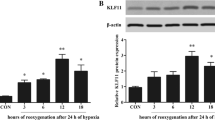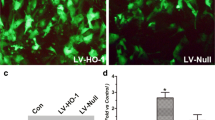Abstract
Myocardial infarction (MI) is a myocardial necrosis disease caused by continuous ischemia and hypoxia. Abnormal expression of aldolase A (ALDOA) has been reported in cardiac hypertrophy, heart failure and other cardio-cerebrovascular diseases. The present study aims to explore the effects of ALDOA on hypoxia/reperfusion (H/R)-induced oxidative stress, and investigate the underlying mechanisms. ALDOA was expressed at a low level in blood samples from MI patients and H/R-induced H9C2 cardiomyocytes. Overexpression of ALDOA suppressed H/R-induced oxidative stress and apoptosis. Using co-immunoprecipitation and protein blots, we demonstrated that ALDOA modulates the Notch 1–Jagged 1 signalling pathway by upregulating VEGF. Taken together, our data reveal that ALDOA protects cardiomyocytes from H/R-induced oxidative stress through the VEGF/Notch 1/Jagged 1 axis, and should be investigated as a therapeutic target for the treatment of MI in future.





Similar content being viewed by others
References
Li R, Geng H-H, Xiao J, Qin X-T, Wang F, Xing J-H, Xia Y-F, Mao Y, Liang J-W, Ji X-P (2016) miR-7a/b attenuates post-myocardial infarction remodeling and protects H9c2 cardiomyoblast against hypoxia-induced apoptosis involving Sp1 and PARP-1. Sci Rep 6:29082
Margherita N, Vittorio F, Marco DP, Cristoforo P, Irene R, Emanuela T, Daniela C (2015) Cardiac oxidative stress and inflammatory cytokines response after myocardial infarction. Curr Vasc Pharmacol 13:26–36
Anderson JL, Morrow DA (2017) Acute myocardial infarction. N Engl J Med 376:2053–2064
Lindahl B, Baron T, Erlinge D, Hadziosmanovic N, Nordenskjöld AM, Gard A, Jernberg T (2017) Medical therapy for secondary prevention and long-term outcome in patients with myocardial infarction with non-obstructive coronary artery (MINOCA) disease. Circulation 135:1481–1489
Smedegaard L, Charlot MG, Gislason GH, Hansen PR (2018) Temporal trends in acute myocardial infarction presentation and association with use of cardioprotective drugs: a nationwide registry-based study. Eur Heart J Cardiovasc Pharmacother 4:93–101
Zeng Y, Lv Y, Tao L, Ma J, Zhang H, Xu H, Xiao B, Shi Q, Ma K, Chen L (2016) G6PC3, ALDOA and CS induction accompanies mir-122 down-regulation in the mechanical asphyxia and can serve as hypoxia biomarkers. Oncotarget 7:74526
Hu LJ, Chen YQ, Deng SB, Du Jl, Shen Q (2013) Additional use of an aldosterone antagonist in patients with mild to moderate chronic heart failure: a systematic review and meta-analysis. Br J Clin Pharmacol 75:1202–1212
Li Y, Zhang D, Kong L, Shi H, Tian X, Gao L, Liu Y, Wu L, Du B, Huang Z (2018) Aldolase promotes the development of cardiac hypertrophy by targeting AMPK signaling. Exp Cell Res 370:78–86
Coats CJ, Heywood WE, Virasami A, Ashrafi N, Syrris P, Dos Remedios C, Treibel TA, Moon JC, Lopes LR, McGregor CG (2018) Proteomic analysis of the myocardium in hypertrophic obstructive cardiomyopathy. Circulation 11:e001974
Xu Z, Li C, Liu Q, Yang H, Li P (2019) Ginsenoside Rg1 protects H9c2 cells against nutritional stress-induced injury via aldolase/AMPK/PINK1 signalling. J Cell Biochem 120:18388–18397
Mitra A, Basak T, Ahmad S, Datta K, Datta R, Sengupta S, Sarkar S (2015) Comparative proteome profiling during cardiac hypertrophy and myocardial infarction reveals altered glucose oxidation by differential activation of pyruvate dehydrogenase E1 component subunit β. J Mol Biol 427:2104–2120
Yu M, Lu G, Zhu X, Huang Z, Feng C, Fang R, Wang Y, Gao X (2016) Downregulation of VEGF and upregulation of TL1A expression induce HUVEC apoptosis in response to high glucose stimuli. Mol Med Rep 13:3265–3272
Pastukh V, Roberts JT, Clark DW, Bardwell GC, Patel M, Al-Mehdi A-B, Borchert GM, Gillespie MN (2015) An oxidative DNA “damage” and repair mechanism localized in the VEGF promoter is important for hypoxia-induced VEGF mRNA expression. Am J Physiol 309:L1367–L1375
Zou X, Gu D, Xing X, Cheng Z, Gong D, Zhang G, Zhu Y (2016) Human mesenchymal stromal cell-derived extracellular vesicles alleviate renal ischemic reperfusion injury and enhance angiogenesis in rats. Am J Transl Res 8:4289–4299
Chen L, Xia W, Hou M (2018a) Mesenchymal stem cells attenuate doxorubicin-induced cellular senescence through the VEGF/Notch/TGF-β signaling pathway in H9c2 cardiomyocytes. Int J Mol Med 42:674–684
Chang YC, Chan YC, Chang WM, Lin YF, Yang CJ, Su CY, Huang MS, Wu A, Hsiao M (2017) Feedback regulation of ALDOA activates the HIF-1α/MMP9 axis to promote lung cancer progression. Cancer Lett 403:28
Liu F-Y, Fan D, Yang Z, Tang N, Guo Z, Ma S-Q, Wang H-B, Ma Z-G, Tang Q-Z (2019) TLR9-HIF-1α-VEGF axis is essential for HMGB1-mediate post-myocardial infarction tissue repair. Cell Death Dis 10(7):1–6
Wang J, Chen Y, Yang Y, Xiao X, Chen S, Zhang C, Jacobs B, Zhao B, Bihl J, Chen Y (2016) Endothelial progenitor cells and neural progenitor cells synergistically protect cerebral endothelial cells from Hypoxia/reoxygenation-induced injury via activating the PI3K/Akt pathway. Mol Brain 9:12
Gu Y, Feng Y, Yu J, Yuan H, Yin Y, Ding J, Zhao J, Xu Y, Xu J, Che H (2017) Fasudil attenuates soluble fms-like tyrosine kinase-1 (sFlt-1)-induced hypertension in pregnant mice through RhoA/ROCK pathway. Oncotarget 8:104104
Li GJ, Yang Y, Yang GK, Wan J, Cui DL, Ma ZH, Du LJ, Zhang GM (2017) Slit2 suppresses endothelial cell proliferation and migration by inhibiting the VEGF-Notch signaling pathway. Mol Med Rep 15:1981–1988
Sahara M, Hansson EM, Wernet O, Lui KO, Später D, Chien KR (2014) Manipulation of a VEGF-Notch signaling circuit drives formation of functional vascular endothelial progenitors from human pluripotent stem cells. Cell Res 24:820
Chang YC (2014) Abstract 3365: Aldolase A induces invasion/metastasis of lung cancer through modulating HIF1-α and is a marker for poor clinical outcome. Cancer Res 74:3365–3365
Mourino-Alvarez L, Calvo E, Moreu J, Padial LR, Lopez JA, Barderas MG, Gil-Dones F (1830) Proteomic characterization of EPCs and CECs “in vivo” from acute coronary syndrome patients and control subjects. Biochim Biophys Acta 2013:3030–3053
Hong D, Zeng XW, Ma J, Tong Y, Chen Y (2010) Altered profiles of gene expression in curcumin-treated rats with experimentally induced myocardial infarction. Pharmacol Res 61:142–148
Li-Jun H, Yun-Qing C, Song-Bai D, Jian-Lin D, Qiang S (2013) Additional use of an aldosterone antagonist in patients with mild to moderate chronic heart failure: a systematic review and meta-analysis. Br J Clin Pharmacol 75:1202–1212
Hughes M, Lilleker JB, Herrick AL, Chinoy H (2015) Cardiac troponin testing in idiopathic inflammatory myopathies and systemic sclerosis-spectrum disorders: biomarkers to distinguish between primary cardiac involvement and low-grade skeletal muscle disease activity. Ann Rheum Dis 74:795–798
Cavazzana I, Fredi M, Selmi C, Tincani A, Franceschini F (2017) The clinical and histological spectrum of idiopathic inflammatory myopathies. Clin Rev Allergy Immunol 52:88–98
Pahwa R, Adams-Huet B, Jialal I (2017) The effect of increasing body mass index on cardio-metabolic risk and biomarkers of oxidative stress and inflammation in nascent metabolic syndrome. J Diabetes Complications 31:810
Tullio F, Perrelli M-G, Femminò S, Penna C, Pagliaro P (2016) Mitochondrial sources of ROS in cardio protection and ischemia/reperfusion injury. Ann Cardiovasc Dis 1(2):1006
Calenic B, Miricescu D, Greabu M, Kuznetsov AV, Troppmair J, Ruzsanyi V, Amann A (2015) Oxidative stress and volatile organic compounds: interplay in pulmonary, cardio-vascular, digestive tract systems and cancer. Open Chem. https://doi.org/10.1515/chem-2015-0105
Dey S, DeMazumder D, Sidor A, Foster DB, O’Rourke B (2018) Mitochondrial ROS drive sudden cardiac death and chronic proteome remodeling in heart failure. Circ Res 123:356–371
He Y, Chen L, Ma Q, Chen S (2018) Esculetin inhibits oxidative stress and apoptosis in H9c2 cardiomyocytes following hypoxia/reoxygenation injury. Biochem Biophys Res Commun 501:139–144
Miller JD, Peotta VA, Chu Y, Weiss RM, Zimmerman K, Brooks RM, Heistad DD (2010) MnSOD protects against COX1-mediated endothelial dysfunction in chronic heart failure. Am J Physiol Heart Circ Physiol 298:H1600
Zhang T, Zhang Y, Cui M, Jin L, Wang Y, Lv F, Liu Y, Zheng W, Shang H, Zhang J (2016) CaMKII is a RIP3 substrate mediating ischemia- and oxidative stress-induced myocardial necroptosis. Nat Med 22:175–182
Hurd TR, Prime TA, Harbour ME, Lilley KS, Murphy MP (2007) Detection of reactive oxygen species-sensitive thiol proteins by redox difference gel electrophoresis: implications for mitochondrial redox signaling. J Biol Chem 282:22040–22051
Tien CF, Cheng SC, Ho YP, Chen YS, Hsu JH, Chang RY (2014) Inhibition of aldolase A blocks biogenesis of ATP and attenuates Japanese encephalitis virus production. Biochem Biophys Res Commun 443:464–469
Schutt F, Aretz S, Auffarth GU, Kopitz J (2012) Moderately reduced ATP levels promote oxidative stress and debilitate autophagic and phagocytic capacities in human RPE cells. Invest Ophthalmol Vis Sci 53:5354–5361
Xie H, Sun J, Chen Y, Zong M, Li S, Wang Y (2015) EGCG attenuates uric acid-induced inflammatory and oxidative stress responses by medicating the NOTCH pathway. Oxidative Med Cell Longev 2015:214836
Boopathy AV, Pendergrass KD, Pao Lin C, Young-Sup Y, Davis ME (2013) Oxidative stress-induced Notch1 signaling promotes cardiogenic gene expression in mesenchymal stem cells. Stem Cell Res Therapy 4:43–43
Aquila G, Kostina A, Vieceli Dalla Sega F, Shlyakhto E, Kostareva A, Marracino L, Ferrari R, Rizzo P, Malaschicheva A (2019) The Notch pathway: a novel therapeutic target for cardiovascular diseases? Expert Opin Ther Targets 23:695–710
Pei H, Song X, Peng C, Tan Y, Li Y, Li X, Ma S, Wang Q, Huang R, Yang D (2015) TNF-α inhibitor protects against myocardial ischemia/reperfusion injury via Notch1-mediated suppression of oxidative/nitrative stress. Free Radical Biol Med 82:114–121
Chen L, Xia W, Hou M (2018b) Mesenchymal stem cells attenuate doxorubicin-induced cellular senescence through the VEGF/Notch/TGF-β signaling pathway in H9c2 cardiomyocytes. Int J Mol Med 42:589–596
Funding
No funding.
Author information
Authors and Affiliations
Contributions
XLL conceived and designed the study. GYL, RW and HZ performed the experiments. GYL provided the statistical analysis and wrote the paper. XLL reviewed and edited the manuscript.
Corresponding author
Ethics declarations
Conflict of interest
We have read and understood the conflicts of interest and declare that we have none.
Additional information
Publisher's Note
Springer Nature remains neutral with regard to jurisdictional claims in published maps and institutional affiliations.
Rights and permissions
About this article
Cite this article
Luo, G., Wang, R., Zhou, H. et al. ALDOA protects cardiomyocytes against H/R-induced apoptosis and oxidative stress by regulating the VEGF/Notch 1/Jagged 1 pathway. Mol Cell Biochem 476, 775–783 (2021). https://doi.org/10.1007/s11010-020-03943-z
Received:
Accepted:
Published:
Issue Date:
DOI: https://doi.org/10.1007/s11010-020-03943-z




